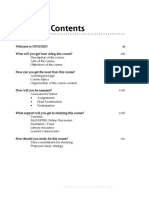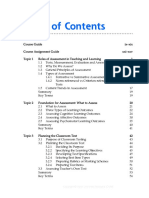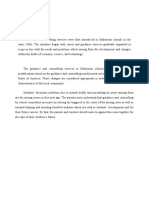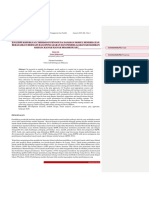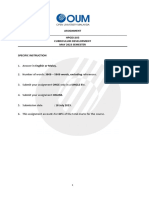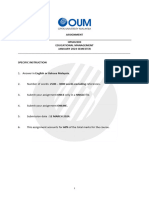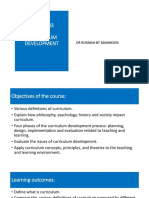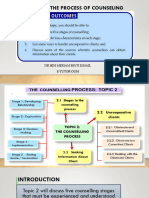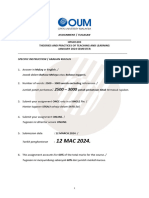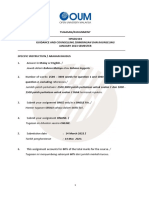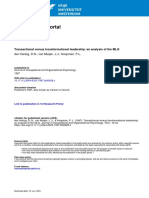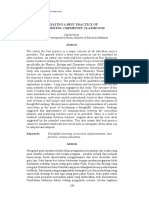04 HPGD2303 CG
04 HPGD2303 CG
Uploaded by
NUR FAIZAH BINTI ROSLAN STUDENTCopyright:
Available Formats
04 HPGD2303 CG
04 HPGD2303 CG
Uploaded by
NUR FAIZAH BINTI ROSLAN STUDENTCopyright
Available Formats
Share this document
Did you find this document useful?
Is this content inappropriate?
Copyright:
Available Formats
04 HPGD2303 CG
04 HPGD2303 CG
Uploaded by
NUR FAIZAH BINTI ROSLAN STUDENTCopyright:
Available Formats
Table of Contents
Welcome to HPGD2303 x
What will You Gain from this Course? x
Description of the Course
Aim of the Course
Course Outcomes
How can You Get the Most Out of this Course? xii
Learning Package
Course Synopsis
Text Arrangement Guide
How will You Be Assessed? xv
What Support will You Get in Studying this Course? xv
Seminars
myINSPIRE Online Discussion
Facilitator
Library Resources
How should You Study for this Course? xvi
Time Commitment for Studying
Proposed Study Strategy
Copyright © Open University Malaysia (OUM)
x COURSE GUIDE
WELCOME TO HPGD2303 EDUCATIONAL
ASSESSMENT
Welcome to HPGD2303 Educational Assessment, which is one of the required
courses for the Postgraduate Diploma in Teaching programme. The course
assumes no previous knowledge of educational assessment but you are
encouraged to tap into your experiences as a teacher, instructor, lecturer or
trainer and relate them to the principles of assessment discussed. This course is
worth 3 credit hours and should be covered over 8 to 15 weeks.
WHAT WILL YOU GAIN FROM THIS COURSE?
Description of the Course
The course discusses the differences between testing, measurement and
assessment or evaluation. The focus is on the role of assessment and followed by
discussion on „what to assess‰, which forms the foundation of assessment. With
regard to the „what‰, emphasis is on cognitive outcomes, affective outcomes
and psychomotor outcomes. Subsequent topics cover the aspect of how to assess
with emphasis on higher-order thinking skills. Besides the usual objective and
essay tests, other authentic assessment techniques such as projects and portfolios
are presented. Also discussed are techniques to determine the effectiveness
of various assessment approaches focussing on reliability, validity and item
analysis. Finally, various basic statistical procedures are presented in the analysis
of assessment results and their interpretation.
Aim of the Course
The main aim of the course is to provide learners with a foundation on the
principles and theories of educational testing and assessment as well as their
applications in the classroom.
Copyright © Open University Malaysia (OUM)
COURSE GUIDE xi
Course Learning Outcomes
By the end of this course, you should be able to do the following:
1. Apply the different principles in the development of assessment techniques
for classroom setting.
2. Plan and construct different classroom tests for different purposes.
3. Perform classroom tests using statistics to analyse and interpret assessment
results.
STUDY SCHEDULE
It is a standard OUM practice that learners accumulate 40 study hours for
every credit hour. As such, for a 3 credit hour course, you are expected to
spend 120 study hours. Figure 1 shows the student learning time (SLT).
Figure 1: Student Learning Time
Copyright © Open University Malaysia (OUM)
xii COURSE GUIDE
HOW CAN YOU GET THE MOST OUT OF THIS
COURSE?
Learning Package
In this Learning Package you are provided with three types of course materials:
1. The Course Guide you are currently reading;
2. The Course Content (consisting of 10 topics);
3. The Course Assessment Guide (which describes the assignments to be
submitted and the examinations you have to sit for); and
4. The Course Online Platform i.e. myINSPIRE Online Discussion.
Please ensure that you have all of these materials and the correct url.
Course Synopsis
To enable you to achieve the four course outcomes, the course content has been
divided into 10 topics. Specific learning outcomes are stated at the start of each
topic indicating what you should be able to achieve after completing each topic.
Topic Title Week
1. The Role of Assessment in Teaching and Learning 1
2. Foundation for Assessment: What to Assess 2ă3
3. Planning the Classroom Test 3
4. Constructing Objective Test Items 4ă5
5. Constructing Essay Tests 6ă7
6. Authentic Assessment 8
7. Project and Portfolio Assessments 8ă9
8. Test Reliability and Validity 10
9. Appraising Classroom Tests and Item Analysis 11
10. Analysis and Interpretation of Assessment Scores 12
Copyright © Open University Malaysia (OUM)
COURSE GUIDE xiii
Topic 1 discusses the differences between testing, measurement, evaluation and
assessment, the role of assessment in teaching and learning and some general
principles of assessment. Also explored is the difference between formative and
summative assessments as well as the difference between criterion- and norm-
referenced tests. The topic concludes with a brief discussion of the current trends
in assessment.
Topic 2 discusses the behaviours to be tested focussing on cognitive, affective
and psychomotor learning outcomes and reasons why assessments of the latter
two outcomes are ignored.
Topic 3 provides some useful guidelines to help teachers plan valid, reliable and
useful assessments. The discussion includes determining what is to be measured
and minimising measurement irrelevancies. The topic will also guide teachers to
devise strategies to measure the domain well. Example of the Table of
Specifications, a 2-way table is presented.
Topic 4 discusses the design and development of objective tests in the assessment
of various kinds of behaviours with emphasis on the limitations and advantages
of using this type of assessment tool.
Topic 5 examines the role of essay tests in assessing various kinds of learning
outcomes as well as its limitations and strengths, and the procedures involved in
the design of good essay questions.
Topic 6 introduces a form of assessment in which learners are assigned to
perform real-world tasks that demonstrate meaningful application of essential
knowledge and skills. Teachers will be able to understand in what way Authentic
Assessment is similar to or different from Traditional Assessment. Emphasis is
also given to scoring rubrics.
Topic 7 discusses in detail two examples of authentic assessments, namely
portfolio and project assessments. Guidelines to portfolio entries and project
works and evaluation criteria are discussed in detail.
Topic 8 focuses on basic concepts of test reliability and validity. The topic also
includes methods to estimate the reliability of a test and factors to increase
reliability and validity of a test.
Copyright © Open University Malaysia (OUM)
xiv COURSE GUIDE
Topic 9 examines the concept of item analysis and the different procedures for
establishing the effectiveness of objective and essay-type tests focussing on item
difficulty and item discrimination. The topic concludes with a brief explanation
of item bank.
Topic 10 focuses on the analysis and interpretation of the data collected by tests.
For quantitative analysis of data, various statistical procedures are used. Some of
the statistical procedures used in the interpretation and analysis of assessment
results are measures of central tendency and correlation coefficients.
Text Arrangement Guide
Before you go through this module, it is important that you note the text
arrangement. Understanding the text arrangement will help you to organise your
study of this course in a more objective and effective way. Generally, the text
arrangement for each topic is as follows:
Learning Outcomes: This section refers to what you should achieve after you
have completely covered a topic. As you go through each topic, you should
frequently refer to these learning outcomes. By doing this, you can continuously
gauge your understanding of the topic.
Self-Check: This component of the module is inserted at strategic locations
throughout the module. It may be inserted after one subtopic or a few subtopics.
It usually comes in the form of a question. When you come across this
component, try to reflect on what you have already learnt thus far. By attempting
to answer the question, you should be able to gauge how well you have
understood the subtopic(s). Most of the time, the answers to the questions can be
found directly from the module itself.
Activity: Like Self-Check, the Activity component is also placed at various
locations or junctures throughout the module. This component may require you
to solve questions, explore short case studies, or conduct an observation or
research. It may even require you to evaluate a given scenario. When you come
across an Activity, you should try to reflect on what you have gathered from the
module and apply it to real situations. You should, at the same time, engage
yourself in higher order thinking where you might be required to analyse,
synthesise and evaluate instead of only having to recall and define.
Copyright © Open University Malaysia (OUM)
COURSE GUIDE xv
Summary: You will find this component at the end of each topic. This component
helps you to recap the whole topic. By going through the summary, you should
be able to gauge your knowledge retention level. Should you find points in the
summary that you do not fully understand, it would be a good idea for you to
revisit the details in the module.
Key Terms: This component can be found at the end of each topic. You should go
through this component to remind yourself of important terms or jargon used
throughout the module. Should you find terms here that you are not able to
explain, you should look for the terms in the module.
References: The References section is where a list of relevant and useful
textbooks, journals, articles, electronic contents or sources can be found. The list
can appear in a few locations such as in the Course Guide (at the References
section), at the end of every topic or at the back of the module. You are
encouraged to read or refer to the suggested sources to obtain the additional
information needed and to enhance your overall understanding of the course.
HOW WILL YOU BE ASSESSED?
Assessment Method
Please refer to myINSPIRE.
WHAT SUPPORT WILL YOU GET IN STUDYING
THIS COURSE?
Seminars
There are 15 hours of seminars or face-to-face interactions supporting the course.
This consists of four to five seminar sessions of 3 hours each. You will be notified
of the dates, times and location of these seminars together with the name and
phone number of your tutor as soon as you are assigned to a tutorial group.
Copyright © Open University Malaysia (OUM)
xvi COURSE GUIDE
MyINSPIRE Online Discussion
Besides the face-to-face tutorial sessions, you have the support of online
discussions. You should interact with other learners and your facilitators using
myINSPIRE. Your participation and contributions to the online discussion will
greatly enhance your understanding of the course content, guide you in the
assignments as well as prepare for the examination.
Facilitator
Your facilitator will mark your assignments and assist you during the course. Do
not hesitate to discuss during the tutorial sessions or online if:
Ć You do not understand any part of the course content or the assigned
readings;
Ć You have difficulty with the self-tests and activities; or
Ć You have a question or problem with the assignments.
Library Resources
The Digital Library has a large collection of books and journals which you can
access using your learner ID.
HOW SHOULD YOU STUDY FOR THIS COURSE?
1. Time Commitment for Studying
You should plan to spend about six to eight hours per topic reading the
notes, performing the self-tests and activities as well as referring to the
suggested readings. You must also schedule your time to participate in
online discussions. It is often more convenient for you to distribute the
hours over a number of days rather than spend one whole day per week on
your studies. Some topics may require more work than others may,
therefore, it is suggested that, on average, you spend approximately three
days per topic.
Copyright © Open University Malaysia (OUM)
COURSE GUIDE xvii
2. Proposed Study Strategy
The following is a proposed strategy for working through the course. If you
encounter any trouble, discuss it with your facilitator either online or
during the seminar sessions. Remember, the facilitator is there to help you.
(a) The most important step is to read the contents of this Course Guide
thoroughly.
(b) Organise a study schedule. Note the time you are expected to spend
on each topic and the date for submission of assignments as well as
seminar and examination dates. These are stated in your Course
Assessment Guide. Note down all this information in one place such
as your diary or a wall calendar. Jot down your own dates for
working on each topic. You have some flexibility as there are 10 topics
spread over a period of 14 weeks.
(c) Once you have created your own study schedule, make every effort to
„stick to it‰. The main reason learners are unable to cope is because
they lag behind in their coursework.
(d) To begin reading a topic:
Ć Remember that in distance learning, much of your time will be
spent READING the course content. Study the list of topics given
at the beginning of each topic and examine the relationship of the
topic to the other topics.
Ć Read the topicÊs learning outcomes (what is expected of you). Do
you already know some of the key points in the topic? What are
the things you do not know?
Ć Read the introduction (to see how it connects with the previous
topic).
Ć Work through the topic (contents of the topic are arranged to
provide a sequence for you to follow through).
Copyright © Open University Malaysia (OUM)
xviii COURSE GUIDE
Ć As you work through the topic, you will be directed to perform
the self-tests at appropriate intervals throughout the topic. This
will enable you to find out if you understand what you have just
read.
Ć Work out the activities stated (to see if you can apply the concepts
learned to real-world situations).
(f) When you have completed the topic, review the learning outcomes to
confirm that you have achieved them and are able to do what is
required.
(g) If you are confident, you can proceed to the next topic. Proceed topic
by topic through the course and try to pace your study so that you
keep to your planned schedule.
(h) After completing all topics, review the course and prepare yourself for
the final examination. Check that you have achieved all the topicsÊ
learning outcomes and the course objectives (listed in this Course
Guide).
FINAL REMARKS
Once again, welcome to the course. To maximise your gain from this course you
should try at all times to relate what you are studying to the real world. Look at
the environment in your organisation and ask yourself whether the ideas
discussed apply. Most of the ideas, concepts and principles you learn in this
course have practical applications. It is important to realise that much of what we
do in education and training has to be based on sound theoretical foundations.
The contents of this course merely address the basic principles and concepts of
assessment in education. You are advised to go beyond the course and continue
with lots of self-study to further enhance your knowledge on educational
assessment.
We wish you success with the course and hope that you will find it interesting,
useful and relevant in your development as a professional. We hope you will
enjoy your experience with OUM and we would like to end with a saying by
Confucius ă „Education without thinking is labour lost‰.
Copyright © Open University Malaysia (OUM)
COURSE GUIDE xix
TAN SRI DR ABDULLAH SANUSI (TSDAS)
DIGITAL LIBRARY
The TSDAS Digital Library has a wide range of print and online resources
for learners. This comprehensive digital library, which is accessible through the
OUM portal, provides access to more than 30 online databases and several of
them are shown in Figure 2. As an OUM learner, you are encouraged to make
full use of the resources available through this library.
Figure 2: Among the Online Databases Available at TSDAS Digital Library
Copyright © Open University Malaysia (OUM)
xx COURSE GUIDE
Copyright © Open University Malaysia (OUM)
You might also like
- Answer in English or Bahasa Malaysia.: Assignment HPGD1103 Curriculum Development September Semester 2019Document7 pagesAnswer in English or Bahasa Malaysia.: Assignment HPGD1103 Curriculum Development September Semester 2019Taufik Pamis100% (1)
- HPGD2303 Educational Assessment - Caug17 (Bookmark) PDFDocument249 pagesHPGD2303 Educational Assessment - Caug17 (Bookmark) PDFFauzi Azrin Md DaminNo ratings yet
- Color PsychologyDocument66 pagesColor PsychologyMarija Veljkovic82% (11)
- Structuralism in PsychologyDocument3 pagesStructuralism in Psychologyarriane67% (6)
- Akhtar Zaiti Binti Azizi (CGS02786926) - Assignment Hmef5023 - V2Document15 pagesAkhtar Zaiti Binti Azizi (CGS02786926) - Assignment Hmef5023 - V2Akhtar ZaitiNo ratings yet
- Hmef 5023 - ElDocument15 pagesHmef 5023 - ElMuniraa MoonNo ratings yet
- Assignment HPGD1203 Theories and Practices of Teaching and Learning May Semester 2022Document6 pagesAssignment HPGD1203 Theories and Practices of Teaching and Learning May Semester 2022Syazliaty SyazNo ratings yet
- Chapter 05 Innovation The Creative Pursuit of Ideas: TruefalseDocument22 pagesChapter 05 Innovation The Creative Pursuit of Ideas: TruefalseLara FloresNo ratings yet
- HPGD2303 Draft AssignmentDocument13 pagesHPGD2303 Draft AssignmentMuhammad Fakhrul Najmi JaafarNo ratings yet
- Postgraduate Diploma in Teaching: Matriculation No: Identity Card No.: Telephone No.: E-Mail: Learning CentreDocument24 pagesPostgraduate Diploma in Teaching: Matriculation No: Identity Card No.: Telephone No.: E-Mail: Learning CentreMuhammad Fakhrul Najmi Jaafar100% (3)
- Take Home Examination: Semester May 2020Document19 pagesTake Home Examination: Semester May 2020Muhammad Fakhrul Najmi Jaafar100% (2)
- ASSIGNMENT Oum Councelling PGDTDocument23 pagesASSIGNMENT Oum Councelling PGDTMuhammad Fakhrul Najmi JaafarNo ratings yet
- HPGD1103Document17 pagesHPGD1103kirah_erahNo ratings yet
- How The Brain Works The Facts Visually Explained-101-150Document50 pagesHow The Brain Works The Facts Visually Explained-101-150TôThànhPhongNo ratings yet
- 04 HPGD2203 CGDocument9 pages04 HPGD2203 CGMuhammad Fakhrul Najmi JaafarNo ratings yet
- 02 Hpgd2303 TocDocument4 pages02 Hpgd2303 TocNUR FAIZAH BINTI ROSLAN STUDENTNo ratings yet
- Assignment QuestionDocument17 pagesAssignment QuestionNurulAfikaNo ratings yet
- Hmef 5023Document13 pagesHmef 5023alexiusbiraiNo ratings yet
- Postgraduate Diploma in TeachingDocument10 pagesPostgraduate Diploma in TeachingSAIYIDATUL SHUFWAH BINTI JABILIN STUDENTNo ratings yet
- Assignment OUMDocument23 pagesAssignment OUMaminzu ZmpNo ratings yet
- Zulaikah HPGD1203Document18 pagesZulaikah HPGD1203zulaikahnadirah93No ratings yet
- HPGD2203 Education ManagementDocument16 pagesHPGD2203 Education ManagementTce ShikinNo ratings yet
- HPGD 2103 - Guidance and CounsellingDocument14 pagesHPGD 2103 - Guidance and CounsellingkhugeshNo ratings yet
- Answers To Sample Questions To Paper 2.12Document9 pagesAnswers To Sample Questions To Paper 2.12RuhulHubbiNo ratings yet
- Pendapat Dan Pandangan Pakar - Pakar Tentang Kurikulum-1Document26 pagesPendapat Dan Pandangan Pakar - Pakar Tentang Kurikulum-1Sulocana SheilaNo ratings yet
- ArtikelDocument14 pagesArtikelIzzah AnizanNo ratings yet
- Assignment HMEF5023 - V2 Educational Leadership September 2022 SemesterDocument7 pagesAssignment HMEF5023 - V2 Educational Leadership September 2022 SemesterTkah WahabNo ratings yet
- Assignment HPGD 2203 Educational Management September 2021 SemesterDocument7 pagesAssignment HPGD 2203 Educational Management September 2021 SemesterHaiqal FirdausNo ratings yet
- Assignment HPGD2103Document4 pagesAssignment HPGD2103chs076 Maria AlkiftiahNo ratings yet
- Take Home Examination: HMEF5023Document14 pagesTake Home Examination: HMEF5023GOMATHI A/P CHELLIAH MoeNo ratings yet
- HPGD2303 Draft AssignmentDocument17 pagesHPGD2303 Draft AssignmentMuhammad Fakhrul Najmi JaafarNo ratings yet
- PGDTDocument2 pagesPGDTMuhammad Fakhrul Najmi JaafarNo ratings yet
- HPGD4606 Practicum Postgraduate Diploma in TeachingDocument15 pagesHPGD4606 Practicum Postgraduate Diploma in TeachingNUR FAIZAH BINTI ROSLAN STUDENTNo ratings yet
- 1.0 Question 1: Critical Review 1.1 Article 1Document22 pages1.0 Question 1: Critical Review 1.1 Article 1Muhammad Fakhrul Najmi JaafarNo ratings yet
- Counselling Draft Remake (HPGD2103)Document22 pagesCounselling Draft Remake (HPGD2103)Muhammad Fakhrul Najmi JaafarNo ratings yet
- Analisis Keperluan Terhadap Pengguna Sasaran Modul Pendekatan Berasaskan Bermain Bagi Pengajaran Dan Pembelajaran Kemahiran Bahasa Kanak-Kanak PrasekolahDocument9 pagesAnalisis Keperluan Terhadap Pengguna Sasaran Modul Pendekatan Berasaskan Bermain Bagi Pengajaran Dan Pembelajaran Kemahiran Bahasa Kanak-Kanak Prasekolahhanie93No ratings yet
- HPGD1203 Theories and Practices of Teaching and LearningDocument6 pagesHPGD1203 Theories and Practices of Teaching and LearningNUR FAIZAHNo ratings yet
- Assignment HPGD3203 Emerging Technologies in Teaching and Learning May 2022 SemesterDocument10 pagesAssignment HPGD3203 Emerging Technologies in Teaching and Learning May 2022 SemesterSyazliaty SyazNo ratings yet
- Assignment / Tugasan HPGD1203 Theories and Practices of Teaching and Learning January 2024 SemesterDocument10 pagesAssignment / Tugasan HPGD1203 Theories and Practices of Teaching and Learning January 2024 SemesterNUR AFIFAH BINTI JAMALUDIN STUDENT0% (1)
- Postgraduate Diploma in Teaching: Matriculation No: Identity Card No.: Telephone No.: E-Mail: Learning CentreDocument25 pagesPostgraduate Diploma in Teaching: Matriculation No: Identity Card No.: Telephone No.: E-Mail: Learning CentreMuhammad Fakhrul Najmi JaafarNo ratings yet
- 27th JULY 2020Document7 pages27th JULY 2020Muhammad Fakhrul Najmi JaafarNo ratings yet
- HPGD1103Document14 pagesHPGD1103aton hudaNo ratings yet
- MyINSPIRE Guide For StudentsDocument47 pagesMyINSPIRE Guide For StudentsKee CHNo ratings yet
- Em - Question Assignment - Jan 24Document9 pagesEm - Question Assignment - Jan 24afieqafariha1904No ratings yet
- Curriculum Development (Bi)Document19 pagesCurriculum Development (Bi)ayue.rumnorNo ratings yet
- Lecture 1 Hpgd1103 E-Tutorial Part1 May 2021Document28 pagesLecture 1 Hpgd1103 E-Tutorial Part1 May 2021NUR FAIZAH BINTI ROSLAN STUDENTNo ratings yet
- Draft HMEF5063 - V2 Guide - CounselingDocument15 pagesDraft HMEF5063 - V2 Guide - CounselingThenaamutan AmuthanNo ratings yet
- Arahan AssignmentDocument20 pagesArahan AssignmentizzatiNo ratings yet
- hpgd2103 Topic 2-Edit Student BI-versi StudentDocument43 pageshpgd2103 Topic 2-Edit Student BI-versi Studentrubby dean100% (2)
- HPGD2303 EducationalassessmentDocument36 pagesHPGD2303 Educationalassessmenterza wanyNo ratings yet
- Education AssestmentDocument8 pagesEducation Assestmentaton hudaNo ratings yet
- Open University MalaysiaDocument5 pagesOpen University MalaysiaAiman YatimNo ratings yet
- Assignment HPGD3103 Instructional Technologies May 2021 SemesterDocument6 pagesAssignment HPGD3103 Instructional Technologies May 2021 SemesterANIS SYAHMI BINTI MOHD ASRINo ratings yet
- Assignment Hpgd2103Document13 pagesAssignment Hpgd2103nurul amiraNo ratings yet
- 06 HPGD2103 T2Document30 pages06 HPGD2103 T2hanis rahmanNo ratings yet
- Soalan Assignment HPGD3103 May 2020Document7 pagesSoalan Assignment HPGD3103 May 2020chs076 Maria AlkiftiahNo ratings yet
- HPGD3103 Instructional TechnologiesDocument13 pagesHPGD3103 Instructional TechnologiesUina Jo100% (1)
- 019 MaryamDocument7 pages019 MaryamIzatul AzmaNo ratings yet
- Tugasan HPGD1203 Theories and Practices of Teaching and LearningDocument12 pagesTugasan HPGD1203 Theories and Practices of Teaching and Learningnasratulhuda92No ratings yet
- Take Home Examination - Hmef5023 - v2 Leong Yen XinDocument12 pagesTake Home Examination - Hmef5023 - v2 Leong Yen XinLeongYenXin100% (2)
- Assigment - Hmef5023v2 - Educational LeadershipDocument42 pagesAssigment - Hmef5023v2 - Educational LeadershipHanani Izzati100% (1)
- Guidence and Caunselling Final ExamDocument6 pagesGuidence and Caunselling Final Examjalan sungaiNo ratings yet
- Tugasan/Assignment HPGD2103 Guidance and Counselling /bimbingan Dan Kaunseling January 2023 SemesterDocument10 pagesTugasan/Assignment HPGD2103 Guidance and Counselling /bimbingan Dan Kaunseling January 2023 SemesterSITI RUHAIDA BINTI MUSTAFA STUDENT0% (1)
- 04 BBNP4103 CGDocument6 pages04 BBNP4103 CGChistina YukiNo ratings yet
- Cooperative Learning and How To Use It in The ClassroomDocument4 pagesCooperative Learning and How To Use It in The ClassroomNUR FAIZAH BINTI ROSLAN STUDENTNo ratings yet
- 21st C Learning SkillsDocument6 pages21st C Learning SkillsNUR FAIZAH BINTI ROSLAN STUDENTNo ratings yet
- Scheme of Work March 2018Document6 pagesScheme of Work March 2018NUR FAIZAH BINTI ROSLAN STUDENTNo ratings yet
- HPGD4606 Practicum Postgraduate Diploma in TeachingDocument15 pagesHPGD4606 Practicum Postgraduate Diploma in TeachingNUR FAIZAH BINTI ROSLAN STUDENTNo ratings yet
- 21st C Teaching PracticesDocument4 pages21st C Teaching PracticesNUR FAIZAH BINTI ROSLAN STUDENTNo ratings yet
- Problem-Based Learning Vs Project-Based LearningDocument13 pagesProblem-Based Learning Vs Project-Based LearningNUR FAIZAH BINTI ROSLAN STUDENTNo ratings yet
- 06 HPGD2303 Course Assignment GuideDocument6 pages06 HPGD2303 Course Assignment GuideNUR FAIZAH BINTI ROSLAN STUDENTNo ratings yet
- Schools and The FutureDocument14 pagesSchools and The FutureNUR FAIZAH BINTI ROSLAN STUDENTNo ratings yet
- Lecture 1 Hpgd1103 E-Tutorial Part1 May 2021Document28 pagesLecture 1 Hpgd1103 E-Tutorial Part1 May 2021NUR FAIZAH BINTI ROSLAN STUDENTNo ratings yet
- Quality Management in EducationDocument15 pagesQuality Management in EducationNUR FAIZAH BINTI ROSLAN STUDENTNo ratings yet
- Transactional Vs Transformational LeadershipDocument18 pagesTransactional Vs Transformational LeadershipNUR FAIZAH BINTI ROSLAN STUDENTNo ratings yet
- Six Types of PIDocument2 pagesSix Types of PINUR FAIZAH BINTI ROSLAN STUDENTNo ratings yet
- 20 Big Communication MistakeDocument19 pages20 Big Communication MistakeNUR FAIZAH BINTI ROSLAN STUDENTNo ratings yet
- Educational PlanningDocument17 pagesEducational PlanningNUR FAIZAH BINTI ROSLAN STUDENTNo ratings yet
- Seven Habits of Highly Effective PeopleDocument27 pagesSeven Habits of Highly Effective Peoplemukesh427No ratings yet
- Higher Diploma in Early Childhood Education: Theoretical Bases For Child-Centered Play Therapy (I)Document3 pagesHigher Diploma in Early Childhood Education: Theoretical Bases For Child-Centered Play Therapy (I)Wong Yuet YanNo ratings yet
- Speech Text: Committee of Weekly Meeting TC 156 MAM 2022 Basic English CourseDocument3 pagesSpeech Text: Committee of Weekly Meeting TC 156 MAM 2022 Basic English Coursehamindar noviannisaNo ratings yet
- What Is Reading ComprehensionDocument3 pagesWhat Is Reading ComprehensionYusuf HussenNo ratings yet
- Weebly Section 1Document8 pagesWeebly Section 1api-417852697No ratings yet
- Bdgo 4103 Introductory Organisation BehaviourDocument16 pagesBdgo 4103 Introductory Organisation BehaviourWa Wa Jackson Wong0% (1)
- M1-Lesson 2 (Art Appreciation)Document21 pagesM1-Lesson 2 (Art Appreciation)Joecel PeligonesNo ratings yet
- Memory and Learning: The Path To UnderstandingDocument17 pagesMemory and Learning: The Path To UnderstandingDavid HansonNo ratings yet
- Fred JonesDocument16 pagesFred Jonesapi-209843775No ratings yet
- Components of The Whole-to-Part ModelDocument6 pagesComponents of The Whole-to-Part ModelEmile ZamoreNo ratings yet
- Course Learning Objectives Self Evaluation Part 2Document3 pagesCourse Learning Objectives Self Evaluation Part 2api-271087867No ratings yet
- Assignment IntelligenceDocument2 pagesAssignment Intelligencelouie0% (1)
- 8505 Pp2 Mathematics Activities Term 3Document36 pages8505 Pp2 Mathematics Activities Term 3Njoka Samuel KNo ratings yet
- SaltMusic Research ReportDocument66 pagesSaltMusic Research Report--No ratings yet
- Creating A Best Practice of Thoughtful Chemistry ClassroomDocument22 pagesCreating A Best Practice of Thoughtful Chemistry ClassroomIzzat AsyrafNo ratings yet
- ET501 Written Assignment Briefing 2021Document3 pagesET501 Written Assignment Briefing 2021alice romagnoliNo ratings yet
- Massaya's Research Proposal of An Analysis of Grammatical Error of Thai Undergraduate StudentsDocument8 pagesMassaya's Research Proposal of An Analysis of Grammatical Error of Thai Undergraduate StudentsMass RachNo ratings yet
- Mbti Ils Ti NotesDocument7 pagesMbti Ils Ti NotesJon AlcazarNo ratings yet
- Sec 1 SupplementalactivitiesDocument10 pagesSec 1 Supplementalactivitiesapi-273256685100% (1)
- The Method of Constant Installation of Present Orientation and Safety (CIPOS) Can Be UsedDocument5 pagesThe Method of Constant Installation of Present Orientation and Safety (CIPOS) Can Be UsedhaserwayNo ratings yet
- Schools Division Office of Cauayan City Villa Luna National High SchoolDocument3 pagesSchools Division Office of Cauayan City Villa Luna National High SchoolMary Jane V. RamonesNo ratings yet
- Direct Teaching of Vocabulary After Reading: Is It Worth The Effort?Document8 pagesDirect Teaching of Vocabulary After Reading: Is It Worth The Effort?Ngân HDNo ratings yet
- CLIL Unit Checklist AteneuDocument2 pagesCLIL Unit Checklist AteneuCarme Florit BallesterNo ratings yet
- Philosophy of ArtDocument8 pagesPhilosophy of ArtAbilawon WandeNo ratings yet
- Core Oralcom Quarter1 Module 1 Lesson 2Document12 pagesCore Oralcom Quarter1 Module 1 Lesson 2Ericka TorralbaNo ratings yet
- Theories of MathematicDocument22 pagesTheories of MathematicCatherine Lee Cheau YihNo ratings yet














